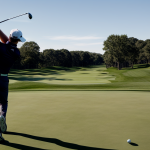As the weather starts to warm up and the days get longer, golfers everywhere are getting ready for the new season. Whether you’re a seasoned pro or a beginner just starting out, preparing for golf season is essential to ensuring a successful and enjoyable experience on the course. In this comprehensive guide, we’ll explore the best tips and techniques for getting ready for golf season, covering everything from physical conditioning to equipment maintenance. So whether you’re looking to improve your game or just have fun on the links, read on for all the advice you need to make the most of your next golf season.
Assessing Your Current Skills and Conditioning
Evaluating Your Physical Fitness
Evaluating your physical fitness is a crucial aspect of preparing for golf season. As a golfer, you need to have a good level of physical fitness to improve your performance on the course. To evaluate your physical fitness, you should consider the following aspects:
- Aerobic capacity: Aerobic capacity refers to your body’s ability to deliver oxygen to your muscles during physical activity. Golf is an aerobic sport, and having a high aerobic capacity can help you to play for longer periods without getting tired. You can evaluate your aerobic capacity by performing a sub-maximal exercise test, such as a 12-minute run or a rowing machine test.
- Muscular strength and endurance: Muscular strength and endurance are essential for golfers, as they require the use of various muscle groups throughout the body. You can evaluate your muscular strength and endurance by performing exercises such as squats, deadlifts, and bench presses. You should aim to perform these exercises with good form and progressively increase the weight as you get stronger.
- Flexibility and mobility: Flexibility and mobility are important for golfers, as they need to have a full range of motion in their joints and muscles. You can evaluate your flexibility and mobility by performing stretching exercises such as hamstring stretches, hip flexor stretches, and shoulder stretches. You should aim to hold each stretch for at least 30 seconds and repeat several times.
By evaluating your physical fitness, you can identify areas that need improvement and develop a training program that is tailored to your specific needs. This will help you to improve your performance on the golf course and reduce the risk of injury.
Analyzing Your Golf Swing
Address Position
The address position refers to the set-up of your body at the beginning of your swing. It is important to ensure that your body is in a balanced and stable position to allow for a smooth and efficient swing. This includes ensuring that your feet are shoulder-width apart, your knees are slightly bent, and your weight is evenly distributed on both feet.
Grip
Your grip is the way you hold the golf club and is crucial to the accuracy and power of your shots. A correct grip should be comfortable and allow for a smooth swing. To achieve this, place your hands on the club, making sure the thumbs are aligned with the index fingers, and the fingers are wrapped around the club.
Stance
Your stance refers to the position of your feet and body in relation to the ball and target. It is important to have a stance that allows for proper balance and alignment, as well as the ability to shift your weight correctly during the swing. A good stance is one where your feet are shoulder-width apart, your knees are slightly bent, and your weight is evenly distributed on both feet.
Swing Plane
The swing plane refers to the path that the club head travels during the swing. A correct swing plane is important for accuracy and power. To achieve a correct swing plane, focus on keeping your arms and club in line with your body and the target throughout the swing.
Impact Position
Impact position refers to the position of the club and ball at the moment of impact. It is important to ensure that the club face is square to the target and that the ball is positioned in the center of your stance. This will help to ensure that the ball is hit with accuracy and power.
Developing a Training Program
Setting Goals
- Improving swing mechanics
- Analyzing the current swing and identifying areas for improvement
- Seeking professional guidance to refine the swing
- Incorporating drills and exercises to reinforce proper mechanics
- Increasing distance
- Assessing current ball speed and distance
- Implementing a regimen to improve ball speed and trajectory
- Utilizing technology such as launch monitors to track progress
- Reducing scoring average
- Evaluating areas of the course where scoring is typically higher
- Developing a plan to improve shot selection and course management
- Tracking progress through scoring and statistical analysis
- Preventing injuries
- Identifying potential areas of injury such as the back, elbow, and wrist
- Incorporating stretching and strengthening exercises to prevent injury
- Consulting with a medical professional for personalized advice and guidance
Creating a Customized Plan
When it comes to developing a training program for golf season, it’s important to create a customized plan that takes into account your individual needs and goals. Here are some tips for creating a customized plan:
- Incorporating physical exercises: In addition to practicing your swing and putting, it’s important to incorporate physical exercises into your training program. This can include strength training, flexibility exercises, and cardiovascular exercise. A personal trainer or fitness coach can help you design a program that meets your specific needs and goals.
- Developing a practice routine: It’s important to have a consistent practice routine in order to improve your skills and build muscle memory. This can include practicing your swing, putting, and chipping, as well as working on your mental game. A coach or instructor can help you develop a practice routine that is tailored to your individual needs and goals.
- Incorporating mental skills training: In addition to physical training, it’s important to work on your mental game. This can include visualization exercises, positive self-talk, and mindfulness techniques. A sports psychologist or mental performance coach can help you develop a mental skills training program that is tailored to your individual needs and goals.
- Including nutrition and recovery strategies: Proper nutrition and recovery are crucial for optimal performance on the golf course. This can include eating a balanced diet, staying hydrated, and getting enough rest and recovery time. A nutritionist or sports performance coach can help you develop a plan that is tailored to your individual needs and goals.
By incorporating these elements into your customized training program, you can improve your physical and mental skills, build muscle memory, and enhance your overall performance on the golf course.
Golf-Specific Exercises
Golf-specific exercises are a crucial component of any training program for golfers. These exercises are designed to improve strength, flexibility, balance, and stability, which are all essential for a successful golf season.
Dynamic stretching
Dynamic stretching is a type of stretching that involves moving parts of your body while you stretch. This type of stretching is especially useful for golfers because it helps to improve range of motion and increase flexibility in the joints. Some examples of dynamic stretches for golfers include:
- Leg swings: Swinging your legs back and forth to improve hip mobility.
- Arm circles: Making large circles with your arms to improve shoulder mobility.
- Torso twists: Twisting your torso from side to side to improve spinal mobility.
Strength training exercises
Strength training exercises are an important part of any golf training program. These exercises help to improve muscular strength and endurance, which can improve your overall golf performance. Some examples of strength training exercises for golfers include:
- Squats: Building lower body strength and improving balance.
- Deadlifts: Building lower back and hamstring strength.
- Shoulder presses: Building shoulder strength and improving posture.
Balance and stability exercises
Balance and stability exercises are essential for golfers because they help to improve your ability to maintain your balance and prevent injuries on the golf course. Some examples of balance and stability exercises for golfers include:
- Single-leg squats: Improving balance and stability by squatting on one leg.
- Plank: Improving core stability by holding a plank position.
- Single-leg deadlifts: Improving balance and lower body strength by lifting a weight with one leg.
Mobility exercises
Mobility exercises are designed to improve your range of motion and flexibility in the joints. These exercises are especially important for golfers because they help to prevent injuries and improve overall golf performance. Some examples of mobility exercises for golfers include:
- Hip openers: Improving hip mobility with exercises such as butterfly stretch or pigeon pose.
- Shoulder mobility exercises: Improving shoulder mobility with exercises such as overhead arm circles or shoulder rolls.
- Wrist and finger stretches: Improving grip strength and flexibility with exercises such as wrist curls or finger stretches.
Implementing Your Plan
Building Consistency
Consistency is key when it comes to improving your golf game. To build consistency, it’s important to establish a regular practice schedule, consistently practice physical and mental skills, and monitor progress and adjust the plan as needed.
- Establishing a regular practice schedule: It’s important to set aside time each day or week to practice your golf skills. This could include time on the driving range, practicing your swing in front of a mirror, or playing on the golf course. The key is to make practice a consistent part of your routine.
- Consistently practicing physical and mental skills: To improve your golf game, it’s important to practice both physical and mental skills consistently. This could include practicing your swing, working on your putting, and practicing your mental focus and concentration. The more you practice, the more consistent you’ll become.
- Monitoring progress and adjusting the plan as needed: It’s important to track your progress and make adjustments to your plan as needed. This could include adjusting your practice schedule, trying new techniques, or seeking out additional resources or support. By monitoring your progress and making adjustments as needed, you can continue to build consistency and improve your golf game.
Staying Motivated
Motivation is key to achieving your goals, especially when it comes to preparing for golf season. Here are some tips to help you stay motivated and on track:
- Setting realistic expectations: It’s important to set realistic expectations for yourself, both in terms of your goals and your progress. This will help you avoid disappointment and frustration, and will give you a sense of accomplishment as you meet each milestone.
- Tracking progress: Keeping track of your progress can be a great way to stay motivated. Whether you use a journal, a spreadsheet, or a fitness app, tracking your progress can help you see how far you’ve come and how much you’ve improved.
- Surrounding yourself with supportive people: Surrounding yourself with supportive people who share your goals and values can be a great way to stay motivated. Whether it’s a golf buddy, a coach, or a family member, having someone to share your journey with can make it more enjoyable and rewarding.
- Celebrating successes: Celebrating your successes, no matter how small, can be a great way to stay motivated. Whether it’s treating yourself to a new golf club or simply taking a day off to relax, celebrating your successes can help you stay focused and energized.
By following these tips, you can stay motivated and on track as you prepare for golf season. Remember, it’s important to set realistic expectations, track your progress, surround yourself with supportive people, and celebrate your successes along the way.
Peak Performance on the Course
Nutrition for Golfers
Maintaining proper nutrition is essential for golfers who want to perform at their best on the course. Here are some tips for optimizing your diet:
- Proper hydration:
Golfers should aim to drink at least 8-10 glasses of water per day to stay properly hydrated. Dehydration can lead to fatigue, dizziness, and other negative effects on the course. It’s also important to consume electrolytes, such as those found in sports drinks, to replace lost minerals during physical activity. - Balanced meals:
Eating a balanced diet is crucial for maintaining energy levels and supporting overall health. Golfers should aim to consume a variety of fruits, vegetables, whole grains, lean proteins, and healthy fats. - Energy-boosting snacks:
Golfers may need a quick energy boost during long rounds or between meals. Snacks such as fruit, nuts, and yogurt can provide a quick source of energy without adding excess calories. - Avoiding performance-inhibiting foods:
Certain foods can interfere with golf performance by causing digestive issues or affecting energy levels. Golfers should avoid foods high in sugar, fat, and salt, as well as foods that may cause bloating or gas. Additionally, golfers should avoid alcohol, which can impair judgement and physical performance.
Mental Game Strategies
As golf is a mental game, having a strong mental game is crucial to success on the course. Here are some strategies to help you develop a strong mental game:
Visualization Techniques
Visualization techniques involve creating mental images of yourself performing well on the course. This can include visualizing your swing, putting, and approach shots. By visualizing yourself performing well, you can improve your confidence and focus on the course.
Focusing on the Process, Not the Outcome
Instead of focusing on the outcome of a shot or a game, it’s important to focus on the process. This means focusing on your technique, your pre-shot routine, and your mental state. By focusing on the process, you can improve your consistency and reduce the pressure you feel on the course.
Managing Stress and Anxiety
Golf can be a stressful and anxiety-inducing sport, but there are ways to manage these feelings. One way is to practice relaxation techniques, such as deep breathing and progressive muscle relaxation. Another way is to practice positive self-talk, which can help you stay calm and focused on the course.
Staying Positive
Having a positive attitude is crucial to success on the course. This means staying positive even when things aren’t going well, and avoiding negative self-talk. Instead, focus on the good things in your game and remind yourself of your strengths. By staying positive, you can improve your mental state and your overall performance on the course.
Pre-Round Warm-Up and Course Management
Proper preparation before teeing off is crucial for optimal performance on the golf course. This section will discuss the pre-round warm-up and course management techniques to help golfers improve their game.
Dynamic stretching and mobility exercises
A pre-round warm-up should include dynamic stretching and mobility exercises to increase range of motion, reduce the risk of injury, and improve overall physical performance. Some effective dynamic stretching exercises include:
- Leg swings: Swinging the legs in a controlled manner to improve hip mobility and range of motion.
- Arm circles: Circling the arms in large motions to increase shoulder mobility and flexibility.
- Torso twists: Twisting the torso from side to side to loosen up the lower back and improve spinal mobility.
These exercises should be performed dynamically, with controlled movements and without holding any static stretches. They should be done at a moderate intensity and for 5-10 minutes before starting the round.
Mental preparation techniques
Mental preparation is an essential aspect of golf performance, as it can help golfers manage stress, stay focused, and maintain confidence throughout the round. Some mental preparation techniques include:
- Visualization: Imagining the shot or hole being played in the mind, including the approach, shot shape, and landing spot.
- Positive self-talk: Encouraging and positive self-talk to boost confidence and reduce anxiety.
- Breathing exercises: Deep breathing and relaxation techniques to manage stress and stay calm under pressure.
These techniques should be practiced regularly and incorporated into the pre-round warm-up routine.
Course management strategies
Course management involves making strategic decisions and playing smart golf to maximize scoring potential. Some effective course management strategies include:
- Reading greens: Analyzing the contours, slopes, and breaks of the putting green to accurately judge the line and speed of the putt.
- Club selection: Choosing the appropriate club for each shot based on distance, wind conditions, and other factors.
- Positioning off the tee: Playing conservatively and avoiding hazards and difficult lies by positioning the ball in the fairway or in a favorable lie.
These strategies should be practiced and refined regularly to improve overall course management skills.
Setting realistic goals for each hole
Setting realistic goals for each hole can help golfers stay focused and motivated throughout the round. Some effective goal-setting techniques include:
- Shot selection: Choosing specific shots to hit based on the hole layout and personal strengths.
- Target placement: Setting realistic targets for the ball’s final resting place based on the hole distance and difficulty.
- Score goals: Setting attainable scoring goals for each hole based on personal skill level and course difficulty.
These goals should be set before starting each hole and adjusted as necessary based on the hole’s difficulty and personal performance.
By incorporating these pre-round warm-up and course management techniques into their routine, golfers can improve their performance on the course and achieve peak performance.
FAQs
1. What is the best way to prepare my golf equipment for the season?
Answer: Preparing your golf equipment for the season is essential to ensure that it is in good condition and performs well throughout the season. The first step is to clean your golf clubs and bag thoroughly. Use a soft cloth or brush to remove any dirt or debris, and then use a golf club cleaner to remove any remaining dirt and grime. It’s also a good idea to check the grips, grooves, and clubheads for any wear and tear, and to replace any damaged parts. Additionally, you should check the tension of your golf bag’s clubs and make sure that all the clubs are accounted for. Finally, you should consider having your golf clubs regripped or restored to improve their performance.
2. How should I maintain my golf swing throughout the season?
Answer: Maintaining a consistent and proper golf swing is crucial to improve your game and avoid injuries. One of the most important things to keep in mind is to practice good posture and alignment. This means keeping your spine straight, your shoulders relaxed, and your feet shoulder-width apart. Additionally, you should focus on maintaining a smooth and fluid swing, using your legs, hips, and core to generate power and control. It’s also important to practice your swing regularly, even if it’s just for a few minutes a day, to keep your muscles loose and your swing smooth. Finally, you should consider working with a golf coach or taking golf lessons to improve your technique and get personalized feedback.
3. What should I do to prepare my body for golf season?
Answer: Preparing your body for golf season is essential to avoid injuries and perform at your best. The first step is to work on your flexibility and mobility. This means stretching regularly to improve your range of motion and prevent stiffness. Additionally, you should focus on strengthening your core, legs, and upper body to improve your balance, stability, and power. It’s also important to work on your cardiovascular fitness to improve your endurance and stamina on the course. You can achieve this by incorporating cardio exercises such as running, cycling, or swimming into your fitness routine. Finally, you should pay attention to your nutrition and hydration, eating a balanced diet and staying hydrated throughout the day to fuel your body and maintain your energy levels.
4. How can I improve my mental game during golf season?
Answer: Improving your mental game is essential to perform at your best and enjoy the game of golf. One of the most important things to keep in mind is to stay focused and positive. This means avoiding distractions, staying in the present moment, and keeping a positive attitude even when things don’t go as planned. Additionally, you should work on your visualization skills, imagining yourself making successful shots and playing the course effectively. It’s also important to practice good course management, taking into account the hole’s layout, hazards, and other factors to make informed decisions and avoid costly mistakes. Finally, you should consider working with a sports psychologist or taking a mental game class to improve your mental toughness and resilience.
5. What should I do to stay safe and prevent injuries during golf season?
Answer: Staying safe and preventing injuries is crucial to enjoy the game of golf and perform at your best. The first step is to wear appropriate golf attire and footwear that provides support and protection. Additionally, you should pay attention to your body and stop playing if you experience any pain or discomfort. It’s also important to warm up and cool down properly before and after your round, to prevent stiffness and soreness. Additionally, you should use proper golf









